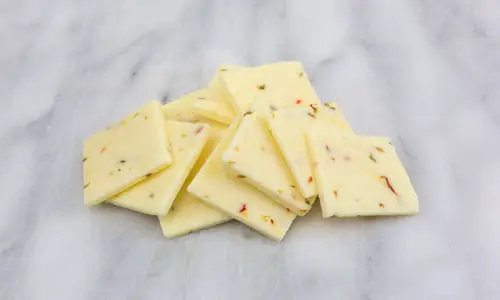Pepper Jack cheese is a semi-soft, cow’s milk cheese with a spicy kick thanks to the jalapeño peppers within it. It can be used in Mexican cooking and as an addition to burgers and grilled cheese sandwiches.
So, what are you to do when you go to make your favorite grilled cheese with Pepper Jack, only to find it has mold growing all over it?
Can you still use it, why did your cheese become moldy in the first place and how can you stop this from happening again?
and how can you stop this from happening again?
In this article, we will be answering all these questions and more, so, for all you need to know about mold growth on pepper Jack cheese, keep reading.

Why does pepper Jack cheese get moldy?
Many types of cheese can grow mold if the conditions are correct for it. All it needs to grow is a source of nutrients, high enough moisture levels, oxygen, and a favorable temperature.
In the case of cheese, the fats, proteins, carbohydrates, and minerals supply all the nutrients required. The mold settles on the cheese, releases enzymes that break it down, and then absorbs all the nutrients it needs.
In terms of moisture, most household refrigerators have an ambient humidity of between 30-50%. As mold needs a humidity of 55%, all it takes is a few food items being left in the fridge before they have cooled properly to raise the humidity levels to an adequate level for mold to use as a source of moisture.
As we will later discuss, improperly storing the cheese will also increase the moisture level directly on and around it, increasing the likelihood of growth.
Temperature is the final requirement, and many strains begin to grow exceptionally well once 40 degrees Fahrenheit is reached. As the most common temperature in US fridges is set to be between 37-40 Fahrenheit, all it takes is a small increase to allow mold to grow rapidly.
Opening the fridge door too frequently, faulty thermostats, broken seals, and warm foods being added to a fridge will all cause the internal temperature to fluctuate, increasing the potential for mold to grow.
What kind of mold grows on pepper Jack cheese?
The most common strain of mold to grow on Pepper Jack cheese is penicillium. This strain is often found growing in soil, on fruits and vegetables, and on rotting vegetation.
This strain is often airborne and so cross-contamination is the most likely cause of it finding its way into or onto your cheese. This can happen at many points during the production stages, including whilst the milk is stored in tanks, during storage, or during transportation. At any of these points, penicillium can find its way onto pepper Jack cheese and create a colony.
What does mold look like on pepper Jack cheese?
During the initial few hours, mold growth is incredibly hard (if not impossible) to spot with the naked eye, however, if left under the correct circumstances, visible patches of circular growth with a white coloration and a velvet-like texture will become apparent.
After several more days, the growth will have spread across the surface of the cheese and may have taken on a blue, blue-green, or olive-green color.
What is the white stuff on your pepper Jack cheese?
As it can often appear in white patches on food items, the white spots that appear on cheeses are often mistaken for mold growth.
There is a very high chance with Pepper Jack Cheese, that these white patches are in fact made up of calcium lactate crystals, which are not only harmless and entirely edible, but also a sign of a well-aged cheese.
To determine whether what you are looking at is mold growth or calcium crystals, take a close look at its texture. Mold will be thread-like and soft, whereas lactate crystals will be gritty and have a sandlike texture if you brush your hand over them.
Is it ok to eat moldy pepper Jack cheese?
No, despite what you may have read or heard in the past, it is never a good idea to eat moldy cheese of any kind.
Molds can produce toxic substances called mycotoxins that can cause unpleasant symptoms such as stomach upset and nausea in some people, and potentially life-threatening allergic reactions in others.
There is also the chance that mold is not the only thing that could be growing, as harmful bacteria such as E. coli tend to form under the same circumstances as mold. And so eating what may appear to be safe cheese could result in food poisoning.
It is for these reasons that if you see mold growing on any part of the cheese, it should be discarded.
Can’t you just cut off the moldy part and eat the rest?
No, it is also not advised to cut off the moldy parts of the cheese and consume what’s left, as attempting to remove the moldy parts can cause a release of spores which then settle on the rest of the cheese, creating new colonies.
The very real and entirely invisible danger of E. coli formation on the cheese is also another consideration. If you see cheese that has become moldy, it is likely beginning to turn rancid. Not only does this make it unpleasant to eat, but it also makes it more likely to harbor harmful bacteria.
Can pepper Jack cheese go bad?
Yes, despite having a lower water content than soft cheeses, Pepper Jack cheese will still go bad eventually. Whilst the added salt will help to lower the moisture levels, halting the breeding of bacteria and the potential for mold growth, the fat within the cheese will still break down and become rancid over time, no matter how well you store it.
Signs your Pepper Jack cheese has started to turn bad include:
- A strong acidic/ammonia smell
- Drying and cracking of the surface
- Mold growth
- Sour taste
How to stop pepper Jack cheese from going moldy
As poor storage is the number one reason for Pepper Jack cheese becoming moldy, the best way to prevent mold from growing in the first place is to ensure that it is being stored correctly.
The following tips will help you to preserve and keep Pepper Jack cheese as fresh as possible.
Wrap the open cheese in parchment paper and plastic wrap
As we stated earlier, mold needs moisture in order to grow, we can remove excess moisture to hinder its growth by lowering the overall humidity available to the cheese.
So, when storing your Pepper Jack, first, wrap it in parchment paper, doing so will absorb excess moisture around the cheese. The next step is to wrap it in plastic wrap, this will prevent cross-contamination with other foods, and stop any odors from permeating the cheese, as well as locking in a small amount of moisture, which keeps the cheese from drying out.
Store it in the bottom of the fridge near the back
The bottom of the fridge has the lowest humidity levels and the most consistent temperature. By placing the cheese towards the back of the fridge, you also help to protect it from temperature fluctuations whenever the fridge door is opened.
Check the use-by date
An open block of Pepper Jack cheese lasts on average 3-4 weeks in a refrigerator, so make sure that you only buy as much cheese as you think you will be able to consume before its use-by date.
Once this date has passed, the cheese is more likely to turn rancid and begin to grow mold and bacteria. You can usually add a few days onto the use-by date without the cheese becoming dangerous to consume, but shortly after this period, noticeable, unpleasant changes in the cheese will occur.
Freeze it
If you have purchased more Pepper Jack cheese than you will be able to consume before its use-by date, you have the option to freeze it.
In order to freeze an open block of Pepper Jack cheese, place it in a zip-lock plastic bag and remove as much air as possible before placing it in the freezer.
Frozen Pepper Jack cheese will still keep its taste and texture for up to one year in the freezer before it begins to deteriorate. The cheese would remain edible after this point, but the taste will become weaker and its texture may also change.
Check the temperature of the fridge
To keep Pepper Jack cheese at its best for the longest time possible, it should be kept at 40 degrees Fahrenheit or slightly below. It is for this reason that you should check that the fridge thermostat is working correctly on a regular basis by placing a thermometer on the top shelf. As heat rises, this is the warmest part of the fridge, so if it maintains a consistent 40 Fahrenheit or below, your cheese will stay fresh and mold-free for the longest time possible.
Conclusion
Pepper Jack cheese is a popular, spicy Mexican cheese. It is a semi-soft cheese that is still susceptible to mold and bacteria growth despite having a lower water content than soft cheeses. The main strain of mold found growing in this type of cheese is Penicillium, and the most effective way to prevent its growth is to wrap the cheese in parchment paper and plastic wrap, then store it in the bottom of the fridge, towards the back.

